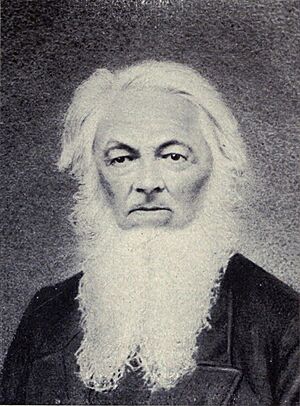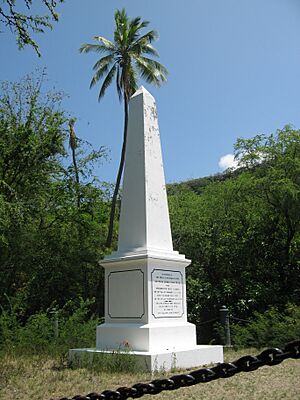Naihe facts for kids
Quick facts for kids Naihe |
|
|---|---|
| Royal Orator and Councilor | |

Naihe and Kalanimoku attending Queen Kamāmalu in a procession during a celebration commemorating the death of Kamehameha I and the ascension of Kamehameha II, 1823.
|
|
| Born | 18th century Kona District, Hawaii |
| Died | December 29, 1831 Hanamua, Kaʻawaloa, Kealakekua Bay |
| Burial | Royal Mausoleum of Hawaii |
| Spouse | High Chiefess Kapiʻolani |
| Father | Keaweaheulu |
| Mother | Ululani |
| Religion | Christianity |
Naihe (died 1831) was an important leader in the early days of the Kingdom of Hawaii. He was a great speaker and advisor to the kings. When he was young, he was a champion athlete. He also helped keep peace and protect important historical items.
Contents
Early Life and Skills
Naihe was born in the 18th century in the Kona District on Hawaii Island. His father was Keawe-a-Heulu, a chief legal advisor to King Kamehameha I. His mother was High Chiefess Ululani from Hilo.
The name Naihe can mean "many spears" in the Hawaiian language. It also suggests having authority through calm and quiet words. Naihe was known for settling conflicts with fairness, which was more powerful than physical weapons.
In his youth, Naihe was a champion athlete and surfer. Old Hawaiian chants describe his amazing surfing skills. He even helped King Kamehameha I move the Pohaku Naha, a huge sacred stone. This stone showed Kamehameha's strength and power. Naihe likely traveled with Kamehameha during his battles to unite the islands. He learned how to give inspiring speeches to the troops.
Building the Hawaiian Kingdom
After the Kingdom of Hawaii was formed around 1800, Naihe hoped for a peaceful life. He settled with his wife, Chiefess Kapiʻolani, in Kaʻawaloa, near Kealakekua Bay. He served as a magistrate, which is like a judge, for the south Kona district.
In 1819, King Kamehameha I died. His wife, Queen Kaʻahumanu, announced that the old Hawaiian traditions, called kapu, were no longer in effect. This was a huge change for the Hawaiian people.
Later that year, a chief named Keaoua Kekuaokalani gathered people who wanted to keep the old ways. He threatened a rebellion. Naihe and another chief, Hoapili, were sent to talk with him. Naihe respected the old traditions but strongly urged for peace. Sadly, the next morning, the groups fought in the Battle of Kuamoʻo, and the rebellion was stopped.
Major Changes and New Ideas
In late 1820, Naihe and Kapiʻolani moved with the royal court to Lahaina and Honolulu. There, they learned to read and write from missionaries. Before this, Hawaiian was only a spoken language. Naihe, being an expert speaker, quickly learned to read and write.
In 1823, they moved back to Kaʻawaloa. The first missionaries to the island, Asa and Lucy Goodale Thurston, joined them. By 1824, Naihe and Kapiʻolani had built a thatched house near their home for Sunday church services.
In 1823, a British missionary named William Ellis visited Hawaii. He was looking for places to build churches. Naihe hosted him, and Kaʻawaloa was chosen as one of the first church sites.
In 1825, Lord Byron arrived on the ship HMS Blonde. He brought the bodies of King Kamehameha II and his Queen Kamāmalu. They had died while visiting England. Naihe went to Honolulu for the royal funeral. This was the first time a Hawaiian King had a Christian memorial service.
Naihe helped organize a meeting to decide who would be the next ruler and to discuss new laws. Some chiefs wanted to quickly adopt a Parliamentary system like the one in England. Naihe, however, argued for a slower approach. He wanted to keep existing laws to ensure stability. He believed the more democratic system should be adopted over time. Naihe lived among the people and understood the challenges of big social changes. The official legislative body of the Kingdom was not fully set up until the 1840 Constitution.
Lord Byron called Naihe's district "one of the most civilized of the Sandwich Islands." In July 1825, Naihe led the British to an ancient religious site called Puʻuhonua o Hōnaunau. He allowed them to remove many wooden carvings and other items from the Hale o Keawe burial site. When the Blonde left Hawaii, Naihe and Kapiʻolani were there to say goodbye.
On September 27, 1826, Naihe gave a speech at the opening of the first wooden church, Mokuaikaua Church, in Kailua-Kona. In 1827, he made a rule that all marriages in his district should be performed by a minister. In 1828, Naihe allowed missionaries to build on his farmland. This area later became known for Kona coffee.
In 1829, Naihe and Kapiʻolani visited the ruins of Hale o Keawe. They saw the damage there. The remaining bones were placed in two large coffins and hidden in a cave. Later, in 1858, they were moved to the Royal Mausoleum of Hawaii.
In November 1829, the USS Vincennes arrived. This was the first time a U.S. Navy ship sailed around the world. Naihe and Kapiʻolani welcomed the officers and served them tea at their home.
On April 1, 1831, Naihe was made Governor of Hawaii Island. This happened while another chief, John Adams Kuakini, was busy restoring order on Oʻahu island.
Naihe passed away on December 29, 1831, after suffering a stroke. Lucy Goodale Thurston, a missionary, described him as a tall man with refined manners. She said he was a very fluent and eloquent speaker, known as the "national orator." She also noted that as a judge, he was firm but kind. When he had to sentence someone, tears would often run down his cheeks.
Naihe's Legacy
People in the Kona district still tell stories about Kai mimiki o Naihe, which means "the roiling sea of Naihe." This might refer to a tsunami that caused damage in the area around 1868.
Several monuments to Captain Cook were built in front of Naihe's old home near the bay. The first was by Lord Byron in 1825. A more permanent one was built in 1874. The village where Naihe lived was later abandoned. Today, the area is part of the National Register of Historic Places as the Kealakekua Bay Historic District and a state historic park.
Naihe's lands and his position as magistrate were passed down to his wife, Chiefess Kapiʻolani. She later donated some of the land for the Kahikolu Church. After her death, many lands went to Naihe's grand-niece, Analea Keohokālole. She was the mother of the Kalākaua Dynasty, which included future Hawaiian monarchs.





